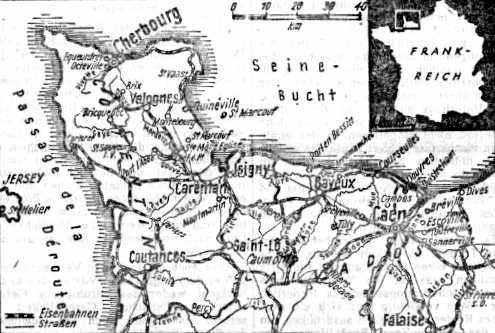The Pittsburgh Press (June 24, 1944)

Roving Reporter
By Ernie Pyle
Barneville, Normandy, France – (by wireless)
From this picturesque little town, you can look down upon the western sea. In the center of Barneville is a slopping paved court, a sort of public square except that it is rectangular instead of square.
At one end of the square, an Army truck was parked. Scattered around the square were half a dozen American soldiers standing in doorways with their rifles ready. There are a few French people on the streets.
We went to the far end of the square, where three local French policemen were standing in front of the mayor’s office. They couldn’t speak any English, but they said there was one woman in town who did, and a little boy was sent running for her. Gradually a crowd of eager and curious people crushed in upon us, until there must have been 200 of them, from babies to old women.
Finally, the woman arrived – a little dark woman with graying hair, and spectacles, and a big smile. Her English was quite good, and we asked her if there were any Germans in the town. She turned and asked the policemen.
Instantly everybody in the crowd started talking at once. The sound was like that of a machine that increases in speed until its noise drowns out all else.
Finally, the policemen had to shush the crowd so the woman could answer us.
She said there were Germans all around, in the woods, but none whatever left in the town. Just then, a German stuck his head out of a nearby second-story window. Somebody saw him, and an American soldier was dispatched to get him.
Barneville is a fortunate place, because not a shell was fired into it by either side. The lieutenant with us told the woman we were glad nobody had been hurt. When she translated this for the crowd, there was much nodding in approval of our good wishes.
We must have stood and talked for an hour and a half. It was a kind of holiday for the local people. They were relieved but still not quite sure the Germans wouldn’t be back. They were still under a restraint that wouldn’t let them open up riotously. But you could sense from little things that they were glad to have us.
A little French shopkeeper came along with a spool of red, white and blue ribbon from his store. He cut off pieces about six inches long for all hands, both American and French.
In a few minutes, everybody was going around with a French tricolor in his buttonhole.
Then a ruddy-faced man of middle age, who looked like a gentleman farmer, drove up in one of those one-horse, high-wheeled work carts that the French use.
He had a German prisoner in uniform standing behind him, and another one, who was sick, lying on a stretcher. The farmer had captured these guys himself, and he looked so pleased with himself that I expected him to take a bow at any moment.
French people kept coming up and asking us for instructions. A man who looked as if he might be the town banker asked what he was supposed to do with prisoners.
We told him to bring them to the truck, and asked how many he had. To our astonishment, he said he had 70 in the woods a couple of miles away, 120 in a nearby town, and 40 in another town.
As far as I could figure it out, he had captured them all himself.
Another worried-looking Frenchman came up. He was a doctor, he said he had 26 badly wounded Germans down at the railroad station and desperately needed medical supplies. He wanted chloroform and sulfa drugs. We told him we would have some sent.
One character in the crowd looked as if he belonged in a novel of Bohemian life on the left bank in Paris. He couldn’t possibly have been anything but a poet. He wore loose, floppy clothes that made him look like a woman. His glasses were thick, and hair about a foot long curled around his ears. I wish you could have seen the expressions of our tough, dirty soldiers when they looked at him.
When we finally started away from the crowd, a little old fellow in faded blue overalls ran up and asked us, in sign language, to come to his safe for a drink. Since we didn’t dare violate the spirit of hands-across-the-sea that was then wafting about the town we had to sacrifice ourselves and accept.
So, we sat down on wooden benches at a long bare table while the little Frenchman puttered and sputtered around. He let two policemen and his own family in, and then took the handle out of the front door so nobody else could get in.
The Germans had drunk up all his stock except for some wine and some eau de vie. In case you don’t know, eau de vie is a savage liquid made by boiling barded wire, soapsuds, watch springs, and old tent pegs together. The better brands have a touch of nitroglycerine for flavor.
So, the little Frenchman filled our tiny glasses. We raised them, tough glasses all around, vived le France all over the place, and goodwill-toward-men rang out through the air and tears ran down our cheeks.
In this case, however, the tears were largely induced by our violent efforts to refrain from clutching at our throats and crying out in anguish. This goodwill business is a tough life, and I think every American who connects with a glass of eau de vie should get a Purple Heart.

